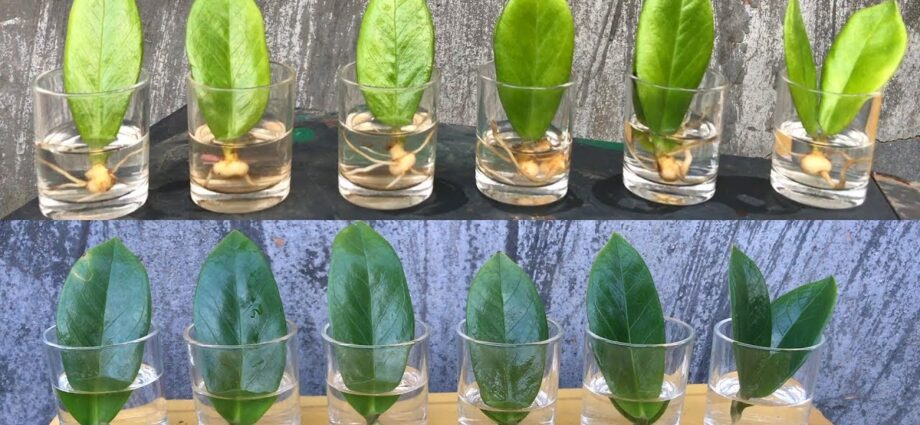Contents
Zamioculcas flower: care features. Video
Zamioculcas is a very beautiful and “convenient” plant for indoor floriculture. It is undemanding to care, it needs to be rarely watered, and in order for the plant to be healthy and juicy, to please its owners for many years, it is enough to follow a few simple rules.
Zamioculcas – female happiness
Zamioculcas is a flower of the aroid family, succulent. Naturally, it grows in the arid mountain regions of East Africa, so the plant perfectly tolerates the dry air of our apartments and offices, as well as insufficient watering.
In Russia, this houseplant appeared quite recently, about 15 years ago, after it was actively cultivated in Holland and sold at flower auctions. A beautiful and undemanding plant almost immediately gained popularity among lovers of indoor floriculture. Thick fleshy stems, luscious shiny foliage of this “stylish handsome” – a real decoration of the home.
Conditions of keeping zamiokulkas
For good growth and development, zamiokulkas requires a very bright place, which must be taken into account if you decide to settle this plant in your home. It is best to place it on a windowsill, however, zamioculcas does not like direct sunlight, which in turn can lead to burn spots on the leaves. The light should be diffused.
In summer, zamiokulkas can be displayed on the balcony or in the garden. The flower responds well to this. He is not picky about air humidity, he feels great in a dry room, he is not afraid of temperature changes. The plant can tolerate rather long periods of insufficient lighting, but it should be borne in mind that when kept in a shaded place, zamioculcas grows very slowly, and sometimes growth stops altogether.
Features of caring for zamioculcas at home
Flower care is simple. This is a great plant for very busy owners. Zamioculcas does not need a constantly moisturized substrate. The plant will not be damaged at all by a rather prolonged “drought”, i.e. when the soil dries out completely. When caring for a plant, you need to remember about the ability of succulents to store moisture for future use. Like all of them, zamioculcas stores moisture in fleshy stems and leaves, and it also has nodules that are located in the thickened lower part of the petiole, and liquid accumulates in them.
The basic rule for watering is moderation. Strong soil moisture, especially in the dark and cold season, can lead to the death of even such a strong plant. With excessive watering, the leaves of the zamioculcas begin to turn yellow and fall off, the tuber rots.
For good growth, the plant requires feeding during the growing season. For this, any complex fertilizers for cacti and succulents are suitable. Feed the plants according to the fertilizer instructions.
Zamioculcas is not afraid of transplantation, so it can be carried out almost annually, but experts still recommend doing this every two years. An indicator for transplanting is that nodules are shown on the surface of the substrate.
The best time to transplant a plant is from February to April. If after that the flower stops growing, do not be discouraged, because after a while it will begin to actively grow again.
Despite its rather impressive size, too large pots of zamiokulkas are not needed, but since adult plants are quite heavy, it is better to choose a ceramic container for planting, with a wide bottom and rather stable.
A mixture of turf or garden soil with sand or a ready-made soil mixture for succulents is suitable as a substrate. But when choosing a soil, pay attention that it does not include peat.
A drainage layer should be poured at the bottom of the container so that there is no stagnation of moisture at the roots of the plant. The surface of the soil can be decorated with small stones, gravel, or planted with miniature sedum species. It is not worth feeding the plant after transplantation. An indicator that the plant needs additional feeding is the appearance of a new leaf after transplanting.
The plant can be propagated during transplantation by dividing the roots into several divisions so that each of them has at least one growth point. Zamioculcas can be propagated by separate leaves, but this is a very long process. Separate the leaf from the plant and plant in a mixture of peat, sand and vermiculite. You can also use peat tablets for this. A year later, a small tuber will appear at the base of the leaf, from which a new plant will subsequently develop.
Features of care for zamioculcas
Subject to the growing conditions, this plant will never get sick. Excessive watering, provided that it is kept in a dark and cold place, planting in a substrate consisting only or mostly of peat – all this can cause fungal or bacterial diseases of zamiokulkas.
To avoid diseases, you should correctly position the flower in the room, adhere to the correct watering regime, and avoid waterlogging of the substrate. It is also necessary to regularly care for the shoots, remove dried and yellowed leaves. Healthy ones should be wiped with a soft damp cloth or cotton pad.
Read also about other indoor flowers here










